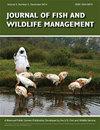Influence of Natural Gas Pipeline Right-of-Ways on Eastern Red-backed Salamander Occurrence in the Northern Appalachians
IF 0.9
4区 环境科学与生态学
Q4 BIODIVERSITY CONSERVATION
引用次数: 0
Abstract
Abstract Road and pipeline infrastructure development for natural gas extraction often results in forest fragmentation, which could negatively influence habitat quality for many amphibian species. We investigated occurrence dynamics of the eastern red-backed salamander Plethodon cinereus in relation to natural gas pipeline rights-of-way (ROW) and forest structure characteristics in northern Pennsylvania. Eighty sites were sampled across two study areas using coverboards, with each site containing sampling plots at the center of the ROW, the edge of the ROW, and 10 m and 30 m into the adjacent forest. We assessed the influence of ROW age, ROW width, distance from ROW, and five forest structure characteristics on plot occupancy probability. Eastern red-backed salamander occupancy probability decreased with ROW age and increased with distance from ROW. Our results indicate that eastern red-backed salamanders are negatively influenced by forest fragmentation for natural gas ROWs. Moreover, responses were time-dependent, with occupancy probability declining with ROW age. Due to low detections, we were unable to analyze data for the other amphibians and reptiles encountered during the study. Our capture data indicate that ROWs could improve habitat quality for some snake species, but additional research is needed to better understand the influence of ROWs on reptile species. To reduce future forest fragmentation and impacts on eastern red-backed salamander populations, managers could consider placing pipelines along existing linear clearings and enhancing the habitat quality of ROWs for salamanders.天然气管道通行权对阿巴拉契亚北部东部红背蝾螈产状的影响
为开采天然气而进行的道路和管道基础设施建设往往会导致森林破碎化,从而对许多两栖动物的栖息地质量产生负面影响。研究了宾夕法尼亚州北部东部红背蝾螈(Plethodon cinereus)的发生动态与天然气管道路权(ROW)和森林结构特征的关系。使用覆盖板对两个研究区域的80个地点进行采样,每个地点在行中心、行边缘以及距相邻森林10米和30米处包含采样地块。我们评估了ROW年龄、ROW宽度、与ROW之间的距离以及5种森林结构特征对地块占用概率的影响。东部红背蝾螈占据概率随ROW年龄的增长而降低,随距ROW距离的增加而增加。研究结果表明,东部红背蝾螈受到森林破碎化的负面影响。此外,反应具有时间依赖性,占用概率随年龄的增长而下降。由于检出率低,我们无法分析研究中遇到的其他两栖动物和爬行动物的数据。我们的捕获数据表明,ROWs可以改善某些蛇类的栖息地质量,但需要进一步的研究来更好地了解ROWs对爬行动物物种的影响。为了减少未来森林破碎化和对东部红背蝾螈种群的影响,管理者可以考虑沿着现有的线性空地铺设管道,并提高蝾螈栖息地的质量。
本文章由计算机程序翻译,如有差异,请以英文原文为准。
求助全文
约1分钟内获得全文
求助全文
来源期刊

Journal of Fish and Wildlife Management
BIODIVERSITY CONSERVATION-ECOLOGY
CiteScore
1.60
自引率
0.00%
发文量
43
审稿时长
>12 weeks
期刊介绍:
Journal of Fish and Wildlife Management encourages submission of original, high quality, English-language scientific papers on the practical application and integration of science to conservation and management of native North American fish, wildlife, plants and their habitats in the following categories: Articles, Notes, Surveys and Issues and Perspectives. Papers that do not relate directly to native North American fish, wildlife plants or their habitats may be considered if they highlight species that are closely related to, or conservation issues that are germane to, those in North America.
 求助内容:
求助内容: 应助结果提醒方式:
应助结果提醒方式:


